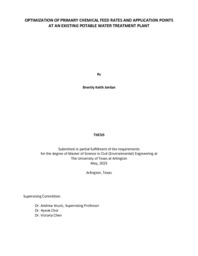
ATTENTION: The works hosted here are being migrated to a new repository that will consolidate resources, improve discoverability, and better show UTA's research impact on the global community. We will update authors as the migration progresses. Please see MavMatrix for more information.
Show simple item record
| dc.contributor.advisor | Kruzic, Andrew | |
| dc.creator | Jordan, Brently Keith | |
| dc.date.accessioned | 2023-06-14T17:08:06Z | |
| dc.date.available | 2023-06-14T17:08:06Z | |
| dc.date.created | 2023-05 | |
| dc.date.issued | 2023-06-05 | |
| dc.date.submitted | May 2023 | |
| dc.identifier.uri | http://hdl.handle.net/10106/31297 | |
| dc.description.abstract | Due to a major upset in the treatment processes for the Dallas County Park Cities Municipal Utility District caused by a required change in treatment techniques, an optimization study was conducted to find the best treatment strategies for the primary coagulation, flocculation, and settled processes for the treatment plant. A methodology for determining how to optimize jar testing while injecting both ferric sulfate and calcium hydroxide in an almost simultaneous manner was developed, and a large number of jar tests were conducted to determine both the best dosages and the best application points of the two chemicals.
As a result of this study, it was determined that the primary contributor for optimal water quality in the primary treatment processes for the District’s treatment plant was the application point of the chemicals used rather than the chemical dosages and/or velocity gradients used during primary treatment. At least for the District’s treatment plant, feeding calcium hydroxide into the exit of the plant’s rapid mixers, while feeding ferric sulfate into the plant’s first stage flocculation basin provides the most optimal treatment of the water.
Two alternate chemicals (a poly ferric sulfate blend for coagulation, and sodium hydroxide rather than calcium hydroxide for pH and alkalinity control) was also investigated. The poly ferric sulfate blend showed inconclusive results (per the manufacturer), and the sodium hydroxide results showed that it is not an acceptable alternative chemical for calcium hydroxide for the District’s treatment plant.
Jar testing for optimization is also not a one-time event. It must be periodically repeated due to changes in raw water quality parameters such as pH, temperature, alkalinity, organic content, and the type and magnitude of raw water turbidity
This study also resulted in a set of recommendations for the treatment plant’s continuing optimization, including weekly and/or as-needed jar testing for optimal chemical dosages, additional research into even more precise optimization procedures, weekly calibration checks of the plant’s coagulant feed pumps, the potential for utilization of magnetic flow metering to monitor actual coagulate feed rates, and adjustments to the plant’s clarifier baffling systems. | |
| dc.format.mimetype | application/pdf | |
| dc.language.iso | en_US | |
| dc.subject | Coagulation | |
| dc.subject | Flocculation | |
| dc.subject | Settling | |
| dc.subject | Jar Tests | |
| dc.subject | Water Quality | |
| dc.subject | Chemical Dosages | |
| dc.title | Optimization of Primary Chemical Feed Rates and Application Points at an Existing Potable Water Treatment Plant | |
| dc.type | Thesis | |
| dc.date.updated | 2023-06-14T17:08:06Z | |
| thesis.degree.department | Civil Engineering | |
| thesis.degree.grantor | The University of Texas at Arlington | |
| thesis.degree.level | Masters | |
| thesis.degree.name | Master of Science in Civil Engineering | |
| dc.type.material | text | |
Files in this item
- Name:
- JORDAN-THESIS-2023.pdf
- Size:
- 5.698Mb
- Format:
- PDF
This item appears in the following Collection(s)
Show simple item record


